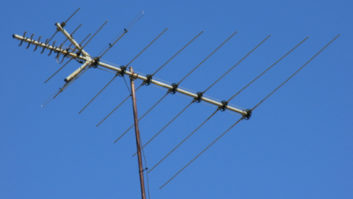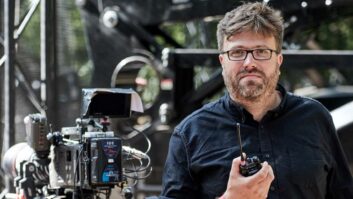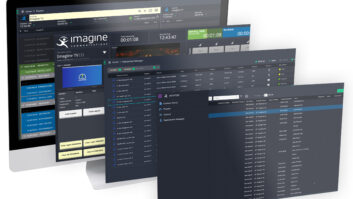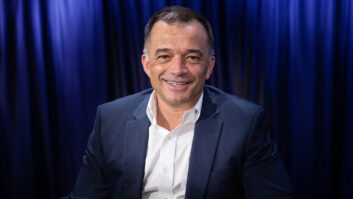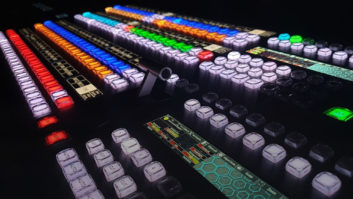Houses of worship have represented a major vertical market within the broadcast and AV industries for some time, but technology advances continually provide new opportunities for ‘spreading the word’ much more effectively. With the rise of social media, congregations no longer only occuply physical seats for services – the congregation can exist wherever there’s a screen. And broadcasts from multiple sites are becoming increasingly common too.
One such enthusiastic tech adopter is SouthBrook Christian Church, near Dayton in the midwestern US state of Ohio. SouthBrook has been established for over thirty years, having gone from being a small group of people meeting in a school, to a church of 5,000 people – and still growing with two campuses, Miamisburg and Liberty.
“AV technology is used for many different purposes all around SouthBrook,” explains technical director Will Scott. “In the main theatre it is primarily used to communicate and educate our Lead Catalyzer’s [lead pastor] message for the week, as well as create an opportunity for people to engage in worship through music. This same principle is applied at various levels throughout the building in different-sized rooms. From the main theatre to our kids’ spaces and conference rooms, almost every room is equipped with both audio and video elements to support communication, education and worship.”
Scott has been working at the church since September last year. Prior to this he held roles as a volunteer mix engineer with various churches in the greater Cincinnati and Dayton area, and as part time technical director at an Adventist church in Kettering.
As well as Scott, SouthBrook has a number of dedicated personnel for staging, lighting and recording the services, which mainly take place at the weekend, though some mid-week events are also scheduled.
“The Worship Arts staff are responsible for the larger venues, but we provide occasional support to the other spaces if a problem should arise,” explains Scott. “The operation of the spaces is carried out by teams of volunteers. We couldn’t make the weekend happen if it wasn’t for our volunteers.”

Dante and Blackmagic
Following the trend we’re seeing across this sector, SouthBrook has incorporated the use of video technology allowing it to communicate more effectively across multiple platforms.
“Recently we’ve switched our audio system from analogue to digital, and incorporated broadcast elements into our system allowing us to stream through social media,” says Scott. “As technology evolves and changes, so must we.”
The evolution of the audio system from analogue to digital involved Scott’s installing Yamaha’s CL series live digital mixing console, and a compact all-in-one Yamaha QL digital console incorporating a built-in Dan Dugan Automixer for microphones, as well as R Series I/O (Rio) racks which employ the Dante network audio protocol.
We generally work under the premise of, if we want to do something, then we figure it out and learn as we go
“Creating a Dante network within our campus has allowed tremendous flexibility for our applications,” reveals Scott. “The biggest challenge was understanding and setting up the network elements, for instance, cable length limitations, how to set up a network switch, assigning IP addresses, and so on.”
“We’ve also deployed a Blackmagic Design UltraStudio Mini Recorder for our broadcast video interface. It’s been very simple to set up,” he adds.
The technology choices were based on reliability and simplicity. “Being a multisite campus, we have to find ways to reproduce what has been created in the main theatre in a different location,” he explains.

Seeds of broadcast
All weekend services are broadcast live online, tapping into the flexibility offered by open source software and social media.
“For broadcast, we take a programme output video signal from our production switcher, where a broadcast audio mix is combined with video, and sent to the UltraStudio Mini, which interfaces to an Apple computer,” explains Scott. “From there we use Open Broadcaster Software (OBS) [for streaming].”
“The broadcast feed is easily maintained. All we do on the weekend is open up Facebook Live, connect it to OBS through the server and a stream key, then go live as soon as our service starts,” Scott reveals.
Developing the streaming live setup was the result of “asking Google lots of questions, and experimentation,” admits Scott. “We generally work under the premise of if we want to do something, then we figure it out and learn as we go.”
All we do on the weekend is open up Facebook Live, connect it to OBS through the server and a stream key, then go live as soon as our service starts
But this is not an amateurish set up. Production values are high.
“We work hard to use cameras and microphones in capturing the experience, then broadcast that experience,” Scott explains. “Most of it comes down to quality programming. Great teaching from our lead catalyzer, great music from our musicians and worship arts director, great lighting and stage looks from our stage and lighting director, and everything working together to support a unified goal. If the programming isn’t good to begin with, then it doesn’t matter how great the cameras, lighting fixtures or sound console is. A good broadcast experience starts simply with the programming and experience in the room.”

We’re church guys, we get it
This standard is maintained through strategic planning, communication and rehearsal. “We spend time during the week perfecting what the weekend experience will be, and continue to evolve and improve until the last service,” Scott adds.
Such dedication, and possibly the reach of social media, is helping to grow SouthBrook’s physical congregation.
“We’re currently expanding our campus to include a Chapel [slated to be completed around September this year], which requires some focus on infrastructure and volunteer training,” says Scott.
Lexington, Kentucky-based House Right Production is the systems integrator supplying the equipment and facilitating all of the AV installation in the chapel. The company’s website slogan – ‘We’re Church Guys. We Get it.’ – should indicate how buoyant this vertical market is.
SouthBrook also seems to be on the up. “There’s quite a bit of exciting discussion coming from our vision team, with further multisite expansion and community engagement to fulfil needs we see in our society beyond that of a traditional church,” enthuses Scott. “I’m looking forward to seeing what the next few years will bring at SouthBrook and its involvement in the surrounding Dayton area. I don’t know what the future holds, but I know that technology will play a huge role in how we interact with each other, and we’ll continue to rely on it for support.”
//pullquotes//
“As technology evolves and changes, so must we”
“Creating a Dante network within our campus has allowed tremendous flexibility for our applications”


